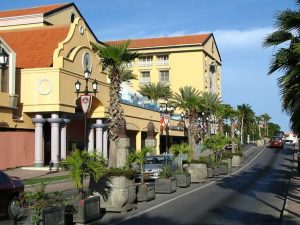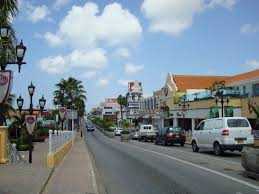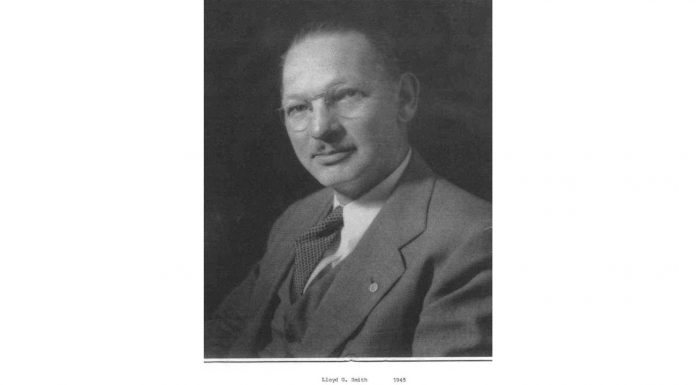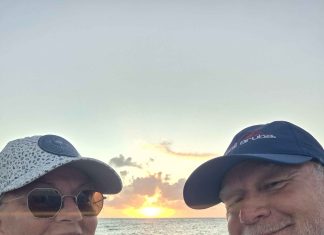Who is that man whose statue is in Oranjestad and after whom the city’s boulevard is named after? This must have been a man of great merit for our island.
Lloyd Gaston Smith was born in Illinois in 1891. In the early 1920s he graduated as a technical draftsman. He went to work for the American Standard Oil Company, was quickly promoted and then was commissioned to design a refinery for Aruba. A subsidiary of Standard Oil, the Lago Oil and Transport Company, had established itself in Aruba with a crude oil transfer point from Lago de Maracaibo, the large shallow lake near that city, where there was an enormous supply of oil . The pumped-up oil was transported in flat-bottomed tankers to the nearest location with a suitable port, and that is why San Nicolas in Aruba was developed. This was realized by the first General Manager, Captain Rodger (Mr. Lago). As soon as the port and the transhipment site were in operation, they also wanted to add a refinery. As early as 1925, the Dutch government had obtained a 99-year concession to use 2,000 hectares south-east of San Nicolas for the establishment of a refinery and a residential area. Remarkably, this decision was taken at the start of the Great Depression, the severe economic crisis that broke out in 1929. The oil industry was then considered a safe investment. Remarkably, this decision was taken at the start of the Great Depression, the severe economic crisis that broke out in 1929. The oil industry was then considered a safe investment. Remarkably, this decision was taken at the start of the Great Depression, the severe economic crisis that broke out in 1929. The oil industry was then considered a safe investment.
Construction of the refinery began in 1928 and was completed in 1933. In addition to the refinery, a residential area for American staffers, known as Lago Colony, was also built. It consisted of about 650 bungalows, a primary and a secondary school, a Protestant church, a hospital, sports fields and a club building and open-air cinema. Two bays with beaches (Rodgers Beach and the Baby Lagoon) made the Colony a luxurious residential area, a kind of American enclave for the higher Lago staff. Everything had previously ge i are are imported, in the first years even drinking water.
Lloyd Smith was appointed General Manager of the Lago in 1933. The family with 6 children came to Aruba by oil tanker and took up residence in one of the bungalows. The construction of a large management house, which was given the name La Casa Grande, Spanish for The Big House, was immediately started, with a view over the Baby Lagoon. The two-storey house was also to serve as accommodation for company staff who came to visit the refinery. The Smith family lived there until 1946. It was taken down shortly afterwards.

The personnel needed was to run the refinery could not be found on Aruba, there was a veritable invasion of workers from other Cara and CARIBBEAN islands, especially the Windward, English-speaking islands. However, both these workers and those from Aruba itself had hardly received any training and had to be completely retrained for the work at the refinery. Smith, himself the son of a school principal, began an extensive training program that was mandatory for all workers. For example, many Arubans have been trained to become skilled foremen, technicians, managers, office and hospital staff, and so on. The living standard of the Aruban increased enormously as a result.
Lloyd G. Smith’s service to Lago and to Aruba in general is invaluable: he built an electricity plant, schools, the church and the hospital in the Colony. He also worked with the Lieutenant Governor (Isaac Wagemaker) in the 1930s and during the war to find solutions for the challenges of the time. The whole island benefited. As early as 1938, Princess Juliana came to Aruba and appointed Smith Knight in the Order of Oranje Nassau.

The outbreak of the Second World War, even though it happened so far away, had a significant impact on life in Aruba. The Lago refinery, at the time the largest and most modern in the world, produced a substantial portion of the fuel the Allies needed, which was one reason for the island to be wary of a hostile attack. Initially there was a Scottish regiment, then American artillery. That hostile attack came anyway, in the night of 15 to 16 February 1942. A German U-boat made an otherwise unsuccessful attempt to bombard the refinery but hit several tankers with torpedoes that went up in flames with a large number of victims . Lloyd G. Smith was very outraged by this attack on his refinery, which, with all the lights on, stood by like a Christmas tree. He ran out of the house cursing in the middle of the night and hurried to the pier where he smashed the lamps with stones. This quick action earned him the nickname The Flash. The damage to the refinery was not too bad, but it was the beginning of a fearful period for Aruba where embezzlement was mandatory from that day on. Smith kept its courage and guided refinery and personnel through these exciting years. In 1945, Princess Juliana came to Aruba again, this time to promote him to Commander in the Order of Oranje Nassau, an honorary title that is very rarely awarded to a non-Dutchman. The damage to the refinery was not too bad, but it was the beginning of a fearful period for Aruba where embezzlement was mandatory from that day on. Smith kept its courage and guided refinery and personnel through these exciting years. In 1945, Princess Juliana came to Aruba again, this time to promote him to Commander in the Order of Oranje Nassau, an honorary title that is very rarely awarded to a non-Dutchman. The damage to the refinery was not too bad, but it was the beginning of a fearful period for Aruba where embezzlement was mandatory from that day on. But Smith kept its courage and guided refinery and personnel through these exciting years. In 1945, Princess Juliana came to Aruba again, this time to promote him to Commander in the Order of Oranje Nassau, an honorary title that is very rarely awarded to a non-Dutchman.
In 1946, Smith was promoted to vice president of the parent company, relocating to New York; his departure from Aruba was regretted by everyone. In 1958, shortly after his retirement, Lloyd G. Smith died of a heart attack. In accordance with his wish, he was cremated and his ashes were scattered in the sea on the shipping route between San Nicolas and Lake Maracaibo. In his memory, a statue, well, a bust, was placed at the roundabout in front of the Cas di Cultura in 1960 and the boulevard from that point to Arashi was named L.G. Smith Boulevard. All this in recognition of his contribution to the success of the Lake, to the growth of the Aruban economy and unfolding of the island.
Source: Historia di Aruba
















